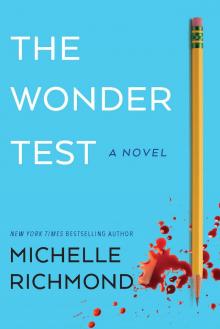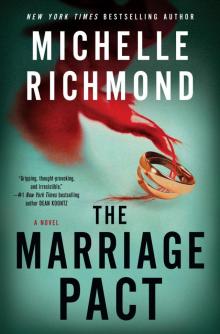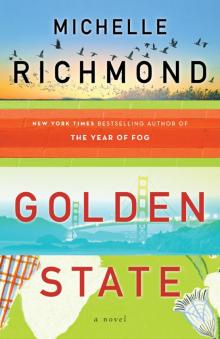- Home
- Michelle Richmond
The Year of Fog
The Year of Fog Read online
Contents
Title Page
Dedication
Epigraph
Acknowledgments
Chapter 1
Chapter 2
Chapter 3
Chapter 4
Chapter 5
Chapter 6
Chapter 7
Chapter 8
Chapter 9
Chapter 10
Chapter 11
Chapter 12
Chapter 13
Chapter 14
Chapter 15
Chapter 16
Chapter 17
Chapter 18
Chapter 19
Chapter 20
Chapter 21
Chapter 22
Chapter 23
Chapter 24
Chapter 25
Chapter 26
Chapter 27
Chapter 28
Chapter 29
Chapter 30
Chapter 31
Chapter 32
Chapter 33
Chapter 34
Chapter 35
Chapter 36
Chapter 37
Chapter 38
Chapter 39
Chapter 40
Chapter 41
Chapter 42
Chapter 43
Chapter 44
Chapter 45
Chapter 46
Chapter 47
Chapter 48
Chapter 49
Chapter 50
Chapter 51
Chapter 52
Chapter 53
Chapter 54
Chapter 55
Chapter 56
Chapter 57
Chapter 58
Chapter 59
Chapter 60
Chapter 61
Chapter 62
Chapter 63
Chapter 64
Chapter 65
Chapter 66
Chapter 67
Chapter 68
Chapter 69
Chapter 70
Chapter 71
Chapter 72
Chapter 73
Chapter 74
Chapter 75
Chapter 76
Chapter 77
Chapter 78
Chapter 79
Chapter 80
Chapter 81
About the Author
Copyright
for Bonnie and John
“Viewfinder cameras have a simple plastic or glass viewer and no adjustable focusing system. The viewer is located just above or to the side of the lens, and indicates approximately what the final photograph will look like (though some parallax problems—the difference between what the eye sees through the viewer and what is actually recorded through the lens—are apparent in the processed negative or print).”
—Henry Horenstein, Black and White Photography: A Basic Manual
“The light of memory, or rather the light that memory lends to things, is the palest light of all….”
—Eugene Ionesco, Present Past, Past Present
ACKNOWLEDGMENTS
The following books were instrumental in my research: The Art of Memory, by Frances A. Yates; Memories Are Made of This, by Rusiko Bourtchouladze; Searching for Memory: The Brain, the Mind, and the Past, by Daniel L. Schacter; The Girl’s Guide to Surfing, by Andrea McCloud; the indispensable website Surfline; and San Francisco’s Richmond District, by Lorri Ungaretti. I came across the confabulatores nocturni in Jorge Luis Borges’s essay “The Thousand and One Nights.”
Thanks to my fabulous agent, Valerie Borchardt, for her belief in this book; my wonderful editor, Caitlin Alexander, for her patience and diligence; Anne Borchardt and Bill U’Ren for their insightful commentary on early drafts; Misty Richmond for her photography expertise; Erin Enderlin and Jay Phelan for early readings; and Jiri Kajane for the excellent souvlaki. I also wish to thank Bay Area Word of Mouth and the folks at Simple Pleasures in San Francisco for support of the moral and caffeinated varieties.
My gratitude to the late Bill White, who gave me a beautiful place to write in Costa Rica. Thanks also to Lawrence Coates, Wendell Mayo, and Bowling Green State University for giving me time and space to complete the book while I was a visiting writer there.
This book would not have made it to publication without the help of Katie Phelan and Purevsuren Sukhbaatar, who gave me precious hours to work by caring for my young son. Speaking of whom, a sleepy shout-out to Oscar for waking me up every morning at 5:00. Above all, thanks to Kevin.
1
HERE IS the truth, this is what I know: we were walking on Ocean Beach, hand in hand. It was a summer morning, cold, July in San Francisco. The fog lay white and dense over the sand and ocean—an enveloping mist so thick I could see only a few feet in front of me.
Emma was searching for sand dollars. Sometimes they wash up by the dozens, whole and dazzling white, but that day the beach was littered with broken halves and quarters. Emma was disappointed. She is a child who prefers things in a state of perfection: sand dollars must be complete, schoolbooks must be pristine, her father’s hair must be neatly trimmed, falling just above his collar.
I was thinking of her father’s hair, the soft dark fringe where it touches his neck, when Emma tugged at my hand. “Hurry,” she said.
“What’s the rush?”
“The waves might wash them away.”
Despite our bad luck so far, Emma believed that on the beach ahead lay a treasure of perfect sand dollars.
“Want to go to Louis’s Diner instead?” I said. “I’m hungry.”
“I’m not.”
She tried to extract her fingers and pull away. I often thought, though I never said it, that her father spoiled her. I understood why: she was a child without a mother, and he was trying to compensate.
“Let me go,” she said, twisting her hand in my own, surprisingly strong.
I leaned down and looked into her face. Her green eyes stared back at me, resolute. I knew I was the adult. I was bigger, stronger, more clever. But I also knew that in a test of will, Emma would outlast me every time. “Will you stay close by?”
“Yes.” She smiled, knowing she had won.
“Find me a pretty sand dollar.”
“I’ll find you the biggest,” she said, stretching her arms wide.
She skipped ahead, that small, six-year-old mystery, that brilliant feminine replica of her father. She was humming some song that had been on the radio minutes earlier. Watching her, I felt a surge of joy and fear. In three months, I would marry her father. We hadn’t yet explained to her that I would be moving in permanently. That I would make her breakfast, take her to school, and attend her ballet recitals, the way her mother used to do. No, the way her mother should have done.
“You’re good for Emma,” Jake liked to say. “You’ll be a much better mother than my ex-wife ever was.”
And I thought, every time, how do you know? What makes you so sure? I watched Emma with her yellow bucket, her blue cloth shoes, her black ponytail whipping in the wind as she raced away from me, and wondered, how can I do it? How can I become a mother to this girl?
I lifted the Holga to my eye, aware as the shutter clicked—once, softly, like a toy—that Emma would be reduced to a blurry 6×6 in black and white. She was moving too fast, the light was insufficient. I turned the winding knob, clicked, advanced again. By the time I pressed the shutter release a final time, she was nearly gone.
2
HERE THEN is the error, my moment of greatest failure. If everyone has a decision she would give anything to retract, this is mine: a shape in the sand caught my eye. At first it looked like something discarded—a child’s shirt, perhaps, or a tiny blanket. By instinct I brought the camera to my eye, because this is what I do—I take pictu
res for a living, I record the things I see. As I moved closer, the furry head came into focus, the arched back, black spots on white fur. The small form was dusted with sand, its head pointing in my direction, its flippers resting delicately at its sides.
I knelt beside the seal pup, reaching out to touch it, but something stopped me. The wet black eyes, open and staring, did not blink. Spiky whiskers fanned out from the face, and three long lashes above each eye moved with the breeze. Then I saw the gash along its belly, mostly hidden by sand, and felt some maternal urge bumping around inside me. How long did I spend with the seal pup—thirty seconds? A minute? More?
A tiny sand crab scuttled over the sand by my toe. The sight of it reminded me of those miniature creatures that littered the beach at Gulf Shores when I was a child. My sister Annabel would capture them in mason jars and marvel at their pink underbellies as they tried to climb out, legs ticking against the glass. This crab kicked up a pocket of sand, then disappeared; at most, another ten seconds passed.
I glanced eastward toward the park, where the fog abruptly ended, butting up against startling blue. As a transplant to this city from the bright and sultry South, I had come to love the fog, its dramatic presence, the way it deadens sound. The way it simply stops, rather than fading, opaque whiteness suddenly giving way to clarity. Crossing from fog into sunlight, one has the feeling of having emerged. Traveling in the other direction is like sinking into a mysterious, fairy-tale abyss.
Just beyond the beach, along the Great Highway, a hearse led a line of cars south toward Pacifica. I remembered the last funeral I attended, a healthy guy in his late twenties who broke his neck in a rock-climbing accident; he was a friend of a friend, not someone I knew well, but because I’d talked with him at a dinner party two weeks before the accident, it seemed appropriate to go to the funeral. This recollection took another five seconds.
I looked ahead, where Emma should be, but did not see her. I began walking. Everything was saturated a cool white, and distance was impossible to measure. I clutched the plastic Holga, imagining the great images I’d get, the deep black of Emma’s hair against the cold white beach.
I couldn’t help thinking of the dead seal pup, how I would explain it to Emma. I believed this was something mothers instinctively knew how to do. This would be a test, the first of many; at that moment I was not thinking entirely of Emma. I walked faster, anxious to know if she had seen the seal; it was a good thing for her to see that day, alone on the beach with me. I wanted her to be frightened by the dead seal pup so I could step delicately into the role of stepmother.
I don’t know exactly when I realized something was wrong. I kept walking and did not see her. I pushed my hands in front of me, aware even as I did so of the absurdity of the gesture, as if a pair of hands could part the fog.
“Emma!” I called.
The panic did not strike immediately. No, that would take several seconds, a full minute almost. At first it was only a gradual slipping, a sense of vertigo, like the feeling I used to get as a child when I would stand knee-deep in the warm water of the Gulf of Mexico, close my eyes against the white-hot Alabama sun, and let the waves erode the platform under my feet. First the sand beneath the arches would go, then the toes, and finally I would lose my balance and tumble forward into the surf, mouth filling with seawater, eyes snapping open to meet the bright spinning world.
“Emma!”
I yelled louder, feeling the shifting, unreliable sand beneath my feet. I ran forward, then back, retracing my steps. She’s hiding, I thought. She must be hiding. A few yards from the dead seal pup stood a concrete drainage wall covered with graffiti. I ran toward the wall. In my mind I pictured her crouched there, giggling, the pail propped on her knees. This vision was so clear, had such the ring of truth, I almost believed I had seen it. But when I reached the wall, she wasn’t there. I leaned against it, felt my insides convulse, and vomited into the sand.
From where I stood, I could make out the shape of the public restrooms down the beach. Racing toward them, I felt a sense of dread. I knew, already, that the search had somehow shifted. I crossed the two-lane-highway and checked the women’s room, which was dark and empty. Then I circled around to the men’s side. The windows were made of frosted glass, dim light spilling onto the tile floor. I plunged my hand into the trash bin, looking for her clothes, her shoes. I got down on hands and knees and looked behind the urinals, holding my breath against the stench. Nothing.
As I crossed back to the beach, I was shaking. My fingers felt numb, my throat dry. I climbed to the top of a sand dune and turned in circles, seeing nothing but the impenetrable white fog, hearing nothing but the soft hum of cars along the Great Highway. For a moment I stood still. “Think,” I said out loud. “Don’t panic.”
Up ahead, more fog, a half mile or so of beach, then the hill leading to the Cliff House, the Camera Obscura, the ruins of the Sutro Baths, Louis’s Diner. To the right, there was the long sidewalk, the highway, and beyond it, Golden Gate Park. Behind me, miles of beach. To my left, the Pacific Ocean, gray and frothing. I stood at the center of a fog-bound maze with invisible walls and infinite possibilities. I thought: a child disappears on a beach. Where does that child go?
3
I WILL RETURN again and again to that moment. I will keep a notebook in which I record the details. There will be poorly done sketches, graphs of time and motion, page after page on which I attempt to recover the past. I will pretend that memory is reliable, that it does not erode as quickly and completely as the brittle lines of an Etch-a-Sketch. I will tell myself that, buried somewhere in the intricate maze of my mind, there is a detail, a clue, some tiny lost thing that will lead me to Emma.
Later, they will want to know the exact moment I noticed she was missing. They will want to know whether I saw anyone unusual on the beach, whether I heard anything in the moments before or after she disappeared. They—the police, the reporters, her father—will ask the same questions again and again, staring into my eyes with desperation, as if by repetition they might make me remember, as if by force of will they can conjure clues where there are none.
This is what I tell them, this is what I know: I was walking on the beach with Emma. It was cold and very foggy. She let go of my hand. I stopped to photograph a seal pup, then glanced up toward the Great Highway. When I looked back, she was gone.
The only person to whom I will tell the entire story is my sister, Annabel. Only my sister will know I wasted ten seconds on a sand crab, five on a funeral procession. Only my sister will know I wanted Emma to see the dead seal, that in the moment before she disappeared, I was scheming to make her love me. For others, I will choose my words carefully, separating the important details from misleading trivialities. For them, I will present this version of the truth: there is a girl, her name is Emma, she is walking on the beach. I look away, seconds pass. When I look back she is gone.
This single moment unfolds like a flower in a series of time-lapse photographs, like an intricate maze. I stand at the labyrinth’s center, unable to see which paths lead to dead ends, which one to the missing child. I know I must trust memory to lead me. I know I have one chance to get it right.
The first story I tell, the first clue I reveal, will determine the direction of the search. The wrong detail, the wrong clue, will inevitably lead to confusion, while the right clue leads to a beautiful child. Should I tell the police about the postman in the parking lot, the motorcycle, the man in the orange Chevelle, the yellow van? Or is it the seal that matters, the hearse, the retaining wall, the wave? How does one distinguish between the relevant and the extraneous? One slip in the narrative, one mistake in the selection of details, and everything disintegrates.
4
PI TIMES radius squared equals the area of a circle. Time is a continuum, stretching forward and back infinitely. I learned these things in school.
In a ninth-grade classroom at Murphy High School, Dr. Thomas Swayze, an exhilarating and shady character who
was rumored to have received his doctorate through the mail, drew a giant circle on the chalkboard. On the outer rim of the circle and on a straight line drawn from the midpoint to the circle’s edge, he scribbled numbers and formulas. His biceps flexed, straining the white sleeve of his T-shirt. “Radius, diameter, circumference,” he said, his FM radio voice inciting in me sweaty adolescent desires. He turned to face the classroom and rolled the gleaming white cone of chalk from palm to palm, looking straight at me.
The sun glared through a long row of windows, turning the copper hair of the girl in front of me to flame; she smelled like Juicy Fruit gum. My hand lay on the desktop in a pool of burning light; all around my thumbnail were flecks of blood where I had chewed the skin to shreds. In my head, a steady, maddening hum. Dr. Swayze turned toward the blackboard. Some hidden object formed a faded and perfect circle on the back pocket of his blue jeans.
“And the greatest of these is area,” he said. My knees slid apart, and I could feel little pools of sweat gathering on the plastic seat beneath my thighs.
Years before, Mrs. Monk, my third-grade teacher, had moved the hands on a giant cardboard clock and extolled the virtues of time. Seconds were grains of sand, she said. Minutes were pebbles. Hours were the bricks of which past, present, and future are made. She talked of days and years, decades, centuries. She talked of the millennium, when we would all be grown. She opened her big arms wide and whispered the word eon. In our portable classroom, the air conditioner sputtering mildly against Mobile’s April heat, Mrs. Monk, teacher of the year for 1977, preached and glowed and sweated.
I sat at my wooden desk, looking up at that huge circle with its eternally trapped hands, and cried. She came over to me and laid warm, damp fingers on my neck. “Abby, what’s wrong?” she asked. I leaned into her ample, motherly waist, buried my face in deep folds of polyester, and confessed, “I don’t understand time.” It wasn’t the clock itself that confounded me, the half-past and quarter-till, the five-of and ten-after, but rather the essential nature of time. I did not have the words to explain this to Mrs. Monk.

 The Wonder Test
The Wonder Test The Year of Fog
The Year of Fog The Marriage Pact
The Marriage Pact Golden State
Golden State Dream of the Blue Room
Dream of the Blue Room No One You Know
No One You Know